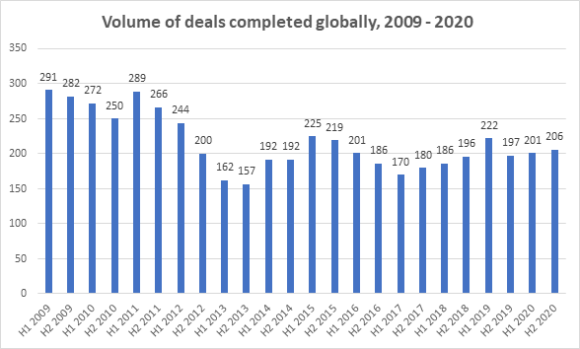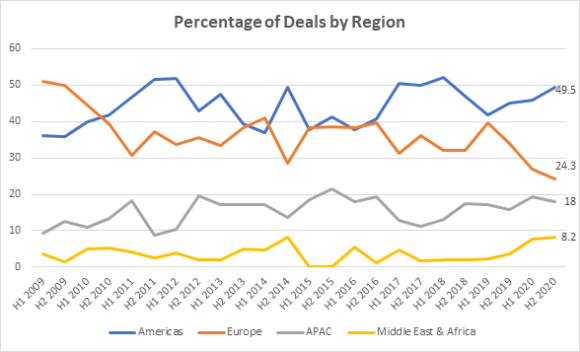There were 407 completed mergers and acquisitions (M&A) worldwide in the insurance sector in 2020, down from 419 the previous year, according to a report published by global law firm Clyde & Co.
An anticipated pandemic-induced dip in activity in the second half of the year failed to materialize, however, with 206 deals in H2 2020, which was slightly up from 201 in the first six months of the year, according to the report titled “Finding opportunity in adversity.”
The Americas remained the most active region for M&A, with 192 deals in 2020, up 6% on 2019. It saw a spike in the second half of the year with 102 transactions – the highest number for five years – up from 90 in the first six months. (See related charts below).
Asia Pacific saw 75 deals, a 9% rise from 69 in 2019, with M&A accelerating through the year, while the Middle East and Africa saw the biggest gains in percentage terms, albeit from a low base, with 32 completed deals in 2020, up from 12 the previous year, a 167% rise.
In contrast, activity in Europe was down by almost a third (34%), year-on-year, to 103 from 155 in 2019.
“Insurance transaction activity worldwide belied expectations in 2020. Dealmakers in the insurance industry, like many others, paused for reflection in the first half of the year, but not for long,” commented Ivor Edwards, head of Clyde & Co’s European Corporate Insurance Group.
“Strategic players in the market and M&A specialists clearly did not want to be relegated to the sidelines and quickly regrouped to identify and pursue opportunities. Given that remote working does not easily lend itself to negotiations, due diligence and all the other elements that make up a transaction, the speed with which companies adapted to the new environment was impressive,” Edwards added.


Widening Pool of Targets
There was a drop-off in blockbuster transactions last year, with 15 mega-deals valued in excess of US$1 billion completed compared to 20 in 2019, according to the report.
But after just six such deals in H1 2020 – including the year’s largest, La Banque Postale’s takeover of French compatriot CNP Assurances for US$6.3 billion – the number edged up with nine in the second half of the year, suggesting appetite for bigger deals is returning, the report said, noting, however, that the coming year will see a widening pool of assets of all sizes becoming available to acquirers.
“The pandemic has forced insurance businesses to review their strategies and get especially focused on which products they want to be underwriting and in which markets,” said Vikram Sidhu, New York-based Clyde & Co. corporate insurance partner.
“A number of firms are actively pursuing opportunities to exit certain non-core businesses through restructurings, divestitures and other deal activity, including to free up capital to redeploy to more preferred areas and products in the hardening market. As a result, legacy transactions will continue to grow and will be a feature of the market in the coming year,” Sidhu continued.
Abundance of Capital
Increasing premium rates and a more optimistic outlook for most lines of business will make stronger market players more likely to look for growth opportunities through acquisitions, some of which may have been put on hold in 2020 due to the pandemic, said the report.
Eva-Maria Barbosa, a partner at Clyde & Co.’s Munich office, commented: “The improving market conditions have seen insurers move to raise capital but are also attracting more funds into the industry, including from private equity, which will help finance more deals. The involvement of PE giants Kelso and Warburg Pincus as part of Arch’s deal to acquire Watford Re is just one example. In addition, with interest rates at historic lows, buyers may look to tap cheap debt or deploy cash stored away during the pandemic to fund acquisitions. Meanwhile, the trend of new players entering the re/insurance market, often backed by an established figure with a proven track record capable of attracting significant financial backing, is set to continue.”
Technology Is Primary Deal Driver
The pandemic has accelerated the adoption of technology across the insurance industry, underpinning deals of every size, the report continued, noting that examples of insurers taking stakes in insurtech start-ups increased across every geography. These included multiple investments into U.S. start-up insurer Hippo Enterprises, propelling its valuation to over US$1 billion; Sompo buying a stake in Japan’s Tier IV, a company leading the development of open-source software for self-driving technology; and Aviva partnering with venture capital firm Anthemis to expand its insurtech investment activity.
“The fallout from COVID-19 has intensified the focus on innovation. When growing your business face-to-face is restricted, you have little choice but to fall back on technology to maintain existing relationships but also to access new markets and grow your customer base,” said Joyce Chan, Hong Kong-based corporate insurance partner. “At the same time, in the face of balance sheet pressure, any innovation that can generate efficiencies and bring down the cost base is welcome. Technology will continue to be a key feature of the growth agenda in the coming year as re/insurers seek out insurtech providers that can deliver a competitive edge, be it through acquisition, investment or partnership.”
M&A Set to Soar in 2021
Given the volume of deals announced in recent months, Clyde & Co. predicts that insurance M&A will surge in the first half of 2021. The number of completed deals worldwide is likely to surpass 220 in a six-month period for the first time since 2019 and could go even higher in the second half of the year, predicted the report.
“Deal-makers’ appetites have returned, buoyed by growing confidence in the economic outlook and the sense that there are opportunities to be had. Despite market hardening, many of the fundamentals driving M&A will persist,” Edwards affirmed. “These include competition for assets, the need to diversify portfolios, add digital capabilities, and increase scale and market share. The availability of plentiful capital, combined with a deeper pool of targets, will give buyers plenty of choice although we expect them to select acquisitions carefully to ensure the best fit with their strategic objectives.”
Source: Clyde & Co.
Topics Mergers & Acquisitions
Was this article valuable?
Here are more articles you may enjoy.



 ‘Clear Soft Market Conditions’ for Commercial P/C Lines in Q3, Says CIAB
‘Clear Soft Market Conditions’ for Commercial P/C Lines in Q3, Says CIAB  Florida Approves 6.9% Average Cut in Workers’ Comp Rates But Roofers Are Worried
Florida Approves 6.9% Average Cut in Workers’ Comp Rates But Roofers Are Worried  Nonstandard Auto Insurers Continue Profit Momentum in 2025: AM Best
Nonstandard Auto Insurers Continue Profit Momentum in 2025: AM Best  Former Lloyd’s CEO Neal Will Not Join AIG; Hancock to Be General Insurance CEO
Former Lloyd’s CEO Neal Will Not Join AIG; Hancock to Be General Insurance CEO 

